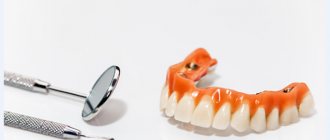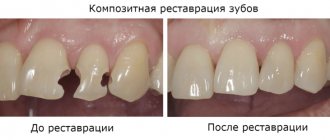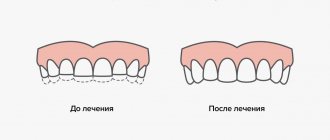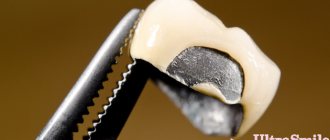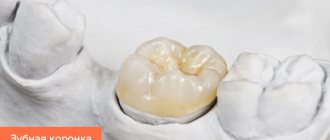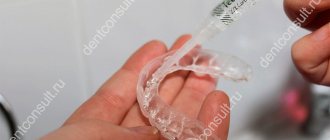Indications and contraindications for tooth augmentation
Teeth augmentation is a multi-stage technology for restoring the aesthetic appearance and functions of the jaw, which was susceptible to chipping or erased as a result of increased tone of the masticatory muscles, called buxism.
Indications for the tooth augmentation procedure:
- chips resulting from injuries;
- numerous caries lesions;
- large distance between teeth;
- wedge-shaped defect;
- the presence of a gap between the two front teeth;
- congenital structural pathologies;
- thinning and demineralization of enamel due to consumption of junk food and lack of oral hygiene;
- cervical caries;
- the presence of errors in previous dental sessions that resulted in the destruction of healthy tissue;
- malocclusion.
Having asked the dentist a question about what tooth extension is called, the patient will immediately hear the answer. The procedure is called dentition restoration. Modern extension technologies make it possible to restore the structure in most cases without resorting to its removal. The procedure is harmless, but has a number of contraindications:
- patient age – more than 60 years;
- children's age when using pins;
- presence of a cyst;
- inflammation of the gums;
- pregnancy in the first or third trimester;
- failure to comply with personal hygiene rules;
- periodontitis and stomatitis;
- jaw fracture and other injuries.
If a patient is diagnosed with diseases that are contraindications, the dentist first treats them, and then restores the dentition.
Advantages and disadvantages of the tooth augmentation procedure
The advantages of extensions include the cost-effectiveness and simplicity of the procedure, and its low invasiveness. It does not require turning or depulping, which means that hard tissues are preserved as much as possible [5]. At the same time, extensions allow you to restore the aesthetically attractive appearance of your smile.
Typically, no anesthesia is used for the procedure, and the procedure itself takes 30-60 minutes [3] and can be performed in just one visit to the dentist.
The disadvantages of building up are associated with the lower density and strength of composite materials in comparison with dental tissues, and their relative porosity [5]. Therefore, the restored parts may become stained, chipped or damaged when eating hard foods such as crackers or nuts [1].
Teeth extension methods
There are 2 main extension methods:
- Straight. Used if tooth decay is up to 30%. During the procedure, composite or photopolymer materials are used to build teeth. The former are less durable and harden after 30 minutes. The latter have a service life of 10 years and remain plastic until exposed to the lamp.
- Indirect. Applicable when damage affects no more than 70% of the structure. The method has several stages, including taking impressions, making and installing ceramic inlays.
If you have ever thought about whether a crown or extension is better, then you should know that a crown is installed when more than 70% of the tissue is destroyed, but a intact and healthy root remains.
Tooth restoration
It is important to understand that if there is the slightest opportunity to reconstruct a damaged tooth, it is necessary to take advantage of it. First of all, the specialist devotes all his efforts to restoring the root, and then to building up the crown. There are quite a lot of restoration methods; preference should be given to one or another option only on the basis of a preliminary examination of the patient’s oral cavity.
One of the options for tooth restoration is the use of a stump tab. It is installed in the root canal, after which prosthetics can begin. An important point: the tab can only be installed on an absolutely healthy root.
Build-up is a technology that involves strengthening the root system of a tooth using a pin. It can be made of fiberglass or metal. Its installation is possible only on the condition that the tooth root is not destroyed and there are no inflammatory processes in it. Experienced dentists work only with the most modern equipment and using hypoallergenic materials, so the results of their work are always excellent.
Features of front teeth extensions
Restoration of anterior teeth is carried out in the following cases:
- Yellowing of enamel;
- Damage to caries;
- Minor curvature;
- Presence of chips or chips;
- Grayish-yellow coating.
Composites and photopolymers are used for extensions, but veneers are the most popular. They are used for minor damage to healthy tissue. If the tooth body is deeply damaged, it is removed from the roots and an implant is implanted in its place. Types of veneers presented in our clinic: composite veneers, ceramic veneers.
Chips of baby teeth often occur in childhood. Many parents do not pay attention to this, hoping for the speedy growth of indigenous children. This is wrong, as the sharp edges scratch the tongue, causing inflammation and infection. Children's extensions are made using composite materials and are absolutely painless.
Tooth injury
Is it possible to restore a damaged tooth?
Any injury to a child is perceived very painfully by parents, and injury to the central teeth causes very intense feelings for all family members. And this is understandable. Pain, possible complications, violations of the aesthetics of a smile - all these worries of parents are understandable, but in vain. Modern dentistry copes well with this problem. Direct restoration is used to restore the aesthetics and function of a damaged tooth.
Why are dental injuries so common in children and what can this lead to?
Children usually receive injuries to their front teeth as a result of falling or hitting hard objects. The most common injury (67.8% of cases) is a fracture of the crown of the central teeth of the upper jaw. This is due to the fact that a common bite is in which the upper central teeth overlap the lower ones, and therefore they take the entire blow. Tooth trauma leads not only to disruption of its integrity, but also to dysfunction, damage to the root and soft tissues.
What period is most dangerous for such injuries?
In young children, acute dental trauma most often occurs at the age of 2.5-3 years. This is explained by the baby’s curiosity and lack of a sense of danger. The peak of injury occurs at 8-10 years of age in the mixed dentition. This is due to the mobility of children, the beginning of active sports, and the lack of proper control over children’s behavior by adults. The situation in this age group is complicated by the fact that the tooth root is not formed. The attending physician faces the task of creating favorable conditions for preserving the vitality of the pulp so that the formation of the tooth root is successfully completed.
What to do if a child breaks a tooth?
First of all, you must immediately seek help from a dental facility that has x-ray equipment. This is due to the fact that it is possible to qualitatively determine the depth of the injury and the location of the fracture of the tooth and bone tissue of the jaws, if any, or to exclude their presence, only with the help of x-rays. Of course, the three-dimensional dental computed tomograph 3D has undeniable capabilities in the field of radiology, which makes it possible to examine the dental system in all planes and identify even hidden damage.
Is there such a tomograph in Volgograd?
Yes, we have it in our clinic. With the help of the “>Morita” 3D tomograph, a few minutes are now enough in any clinical situation to see comprehensive information about the problem. The tomograph is completely safe for patients and medical personnel. The level of its radiation for the human body is 6-10 times less compared to X-ray devices of the previous generation. We accept patients from all dental clinics in the region for examination.
Is it possible to restore a broken tooth to its original form?
Certainly. After the treatment related to the preservation of the tooth, the question will arise about restoring its aesthetics and function. Today, new technologies have replaced the stamped steel crown. Currently, thanks to the advent of dental filling materials with a preventive effect, good adhesion and a wide range of light, it has become possible to restore damaged crowns of primary and permanent teeth using the direct restoration method.
What is the direct restoration method?
Direct restoration is a dental technique by which missing tooth tissue is restored layer by layer with polymer restorative or photopolymerizing composites. These restorations restore the shape, function and aesthetic appearance of the tooth. At the same time, it is very important to choose the right filling material that meets the requirements and meets expectations for the final results of the work.
How successful is this type of work in your clinic?
The doctors at the Lazur dental clinic have accumulated many years of experience in treating children with dental injuries of varying complexity using the direct restoration method. And since 1998, our clinic has completely switched to Swiss materials. With a variety of shades in the color palette, you can choose a color for even the most complex clinical case. It is easy to predict color density and transparency, to repeat the anatomy of tooth tissue. This filling material was the first to use a matrix, which in its optical properties and characteristics is close to natural tooth enamel and is capable of partially refracting, partially reflecting, but most importantly, transmitting light through itself. We immediately appreciated this unique optical ability to make the filling-tooth boundary invisible.
Is it possible to avoid the effect of “missing” teeth in special lighting, for example, at a disco or with a camera flash?
Yes, indeed, this happens - teeth seem invisible in unnatural lighting. This occurs if a material that does not have fluorescent properties was used for restoration. The filling materials used in our clinic provide natural color and allow you to hide the tooth restoration under non-standard lighting conditions. Today, patients are very demanding about the aesthetics and naturalness of reconstructions; “invisibility” of the restoration is becoming a prerequisite. And our task is to fulfill these conditions.
Does a child with a restored tooth need to be seen by a doctor?
Yes need. All cases of dental trauma in children are monitored. Young patients visit their doctors at regular intervals, which allows them to track long-term treatment results.
Tooth extension onto a pin
When thinking about whether it is possible to build a tooth onto the root, the use of a pin comes to mind. It is used if both the body and the root are severely damaged.
The procedure includes:
- obtaining an x-ray;
- cleaning the mouth, removing stones;
- removal of damaged areas;
- computer tooth modeling;
- removal of saliva;
- anesthesia;
- cleaning of channels;
- implantation of a pin, cleansing the area around it;
- filling the space around the pin with a composite or photopolymer;
- polishing and grinding.
Dentists build up teeth under crowns only if the remainder is in good condition and does not rot or decompose.
What to do if a dead tooth breaks at the root?
“Doctor, I was just chewing a soft bun when I felt something crunch.” This is how the patient’s story usually begins about how it happened that some strange stump was left from the tooth. Is it possible to “save” the tooth from removal in such cases? What criteria does the dentist use in such cases? Finally, how exactly to properly restore a tooth in such situations - fill it with a filling, put a crown, “strengthen it with a pin” or something else? We'll talk about this today.
First, just a little theory. Why do dead teeth break so often ? By creating access to the root canals, the doctor removes quite a lot of tissue. In this case, as a rule, the need for root canal treatment is caused by advanced caries, which by the time of treatment has already “eaten” part of the tooth. As a result of these two reasons, after root canal treatment, the patient receives a severely weakened tooth. Some walls may be completely absent, some will be greatly thinned. Imagine an unopened can of cola... or beer (whichever is closer). Try to break it with your hands. This will not be easy to do. Now open it, drink the contents and you will get a model of the tooth with the insides removed and thin walls. You don’t have to be a beefy bodybuilder to be able to easily crush it with your hands. Much the same thing happens with dead teeth. Fragile walls cannot withstand large and constantly repeated cyclic loads during chewing. Our masticatory muscles can develop a force of up to 400 kg cm2. Imagine that such a 400-kilogram young man is riding on your tooth every day.
At the same time, it doesn’t matter at all what you eat: crackers, nuts or fresh bread. Sooner or later, the weakened walls of the tooth will crack. And this result is inevitable.
What to do if a tooth is broken? Should I delete it? Or can it be restored? And, if possible, how to do it better? The main criterion by which the doctor decides on the advisability of preserving the “hemp” is the quantity and quality of hard tissues rising above the gum. Ideally, it should be like this: the edges of the tooth along the entire perimeter are above the level of the gum, the height of the walls is at least 2-3 mm, the thickness is at least 1-2 mm.
Moreover, the higher and thicker the walls, the better the prognosis for restoration. If the tooth wall is chipped deep under the gum, then such teeth often have to be removed. Because no design with a good prognosis can be made for such teeth. If we neglect this rule, then in the very foreseeable future we will get something like this...
...the crown is in the hands, not in the mouth. Any filling, crown, whatever... will not last long on such a root. The main reason for this is that somewhere down there, in the depths of the gums, it is impossible to achieve a perfect fit of any material to the tooth. Any restoration, if done anyway, will begin to “leak” quite quickly under such conditions. This means that the infection living in the oral cavity will easily penetrate into the tooth, “undermining” the tooth from the inside. Therefore, it will be much more reliable to replace such a root with an implant. Of course, you can always find a compassionate dentist-plasterer who will stick something on, apply some grease and at the same time sleep peacefully. But if we are talking about quality and durability, then such options are not for us.
What then for us? Here are some possible correct options for restoring severely damaged dead teeth.
Restoring the tooth stump with a filling + crown.
For example, as in this clinical case. In such cases, a special composite material or amalgam is used to recreate the base of the tooth*
Restoration of the tooth stump with a filling on a fiberglass pin + crown.
Everything is the same, but the filling material is “strengthened” with a pin. This is usually done when there is very little tooth tissue and there is no particular hope for them.
There are many opinions on the advisability of “pinning” teeth, and even among dentists there is no unity on this topic. Some people put pins in all their teeth in a row, others don’t do them at all. The truth, as always, is somewhere in the middle. One thing is for sure - the use of the so-called. anchor metal pins (similar to small screws) today are bad manners.
Stump tab + crown.
In this case, the base for the crown is made in a dental laboratory and is a monolithic structure glued inside the canal. Stump inlays today can be made of metals (cobalt-chromium and gold-platinum alloys) or zirconium dioxide.
These are the main methods for restoring a tooth if it is broken. Each dentist makes the choice between them at his own discretion. The only thing you need to remember: any technique that involves installing a pin in the root canal requires their ideal treatment, because there will be no repeat relatively easy access to them. Therefore, any treatment with pins is in fact the last for the tooth, after which most often only removal is possible. For this and some other reasons, today there is a tendency to move away from the manufacture of any pin structures, especially stump inlays.
So now you know how and what is the best way to restore broken dead teeth.
Does it hurt to grow teeth?
Tooth extension is a painless procedure. Anesthesia is not performed if the damage is not significant, since manipulations are carried out at a superficial level. If the damage is severe, the dentist administers local anesthesia. Modern drugs begin to act immediately after administration.
After the session, the first day you may experience pain if the canals were cleaned. Painkillers will help you feel better.
The restored dentition will last a long time if the patient provides proper care. If the question arises about whether it is possible to smoke after tooth extensions, the answer will be negative. Composite and photopolymer materials quickly absorb all substances, which is why the filling quickly changes color. Maintaining hygiene and regular visits to the dentist will help you maintain your smile for a long time.
Options for restoring a tooth at the root
Today, there are two main methods for restoring the crown of a tooth while preserving its root: direct and indirect. In the first case, the missing part is formed by extension, and in the second, it is manufactured separately in advance. Next, we will consider the most commonly used methods of bone formation restoration.
The pins are made from hypoallergenic and biocompatible materials, so they take root well and do not cause any discomfort to the patient. A crown or filling is placed on the pin. Filling substances rich in fluoride are also actively used. This makes teeth stronger and more resistant to damage. These substances completely imitate the appearance of healthy teeth; they can be selected according to the shade of your enamel.
A core can also be used to reconstruct a broken tooth. It is produced according to individual parameters, taking into account the characteristics of a person’s dentition, which significantly improves the functional properties of the implant. Many patients prefer veneers and lumineers, but this method is only suitable if there is minor damage to the tooth crown. Otherwise, fixing these thin pads will be impossible.
previous post
How to cure a tooth bruise
next entry
Stages of dental prosthetics
Dental prosthetics consists of several stages.
- Preparation. Includes consultation with a doctor, diagnosis, and treatment of dental diseases.
- Manufacturing of orthopedic structures in a dental laboratory (Stompraktika has its own laboratory equipped with the latest technology).
- Trying on the finished design and adjusting it (if necessary).
How much does the procedure cost?
For a complete restoration of a damaged tooth, you will have to pay at least 5,000 rubles. This includes the use of painkillers (200-300 rubles), consumables that isolate the damaged tooth from saliva (approximately 400 rubles). Also, do not forget about sterilizing the set of instruments used - the cost is low, about 100 rubles, but still people often do not take this into account. The main amount spent is spent on the purchase of filling materials, which are used to build up the tooth. This is around 3000 rubles. Also, the use of technology using a pin implies the purchase of an imported product, which also costs a lot. Prices may vary depending on the clinic where the procedure is performed.
Tooth restoration using a fiberglass pin
You can save a lot by using a domestic fiberglass pin, the cost of which is 60-100 rubles. But, as a rule, they do a poor job of fixing the tooth in the root canal.
The cost of tooth augmentation may vary
Regardless of the chosen extension method or materials, the main thing is not the procedure itself, but the subsequent care. After all, what is the point of an expensive procedure if, after installing an artificial tooth, the patient does not follow the rules of oral hygiene? The main thing is to follow the doctor’s recommendations and do not forget that caring for the extended tooth affects its service life. Therefore, it (care) should not be less thorough than caring for living teeth.
What to do after prosthetics?
Caring for fixed orthopedic structures is no different from caring for your own teeth: brush your teeth morning and evening, and rinse your mouth after every meal. If the design is removable and you do not use gel for fixation, then do not forget to wash it after eating. If the removable denture is fixed on the gel, then it is enough to rinse your mouth. Also, twice a week, removable dentures must be cleaned using special tablets. Your doctor will give you a complete list of recommendations.
Prerequisites for performing the procedure
Since the process of restoring the dentition is a way of preserving the remaining part of the damaged tooth, to obtain an optimal result when building up, you must follow some recommendations:
- give up habits that are harmful to your teeth. If there is a pathology such as bruxism, the restored teeth will not be able to serve the owner for long. This also applies to the use of teeth “for other purposes” (opening beer bottles, biting threads, cracking walnuts, and so on);
Give up habits that are bad for your teeth
- caries. You need to get rid of it before starting the extension process. Otherwise, under the installed restorative materials, this process may continue, as a result of which the remaining teeth will have to be removed;
- oral hygiene. Compliance with these rules will extend the service life of the restored tooth. You need to not only perform cleansing procedures, but do it correctly;
- no health problems. As a rule, doctors do not recommend extensions if a person suffers from pathologies of the nervous system or blood;
- tooth mobility. For effective fastening of restoration materials there should be no mobility, otherwise the structure will soon fall out, and the restoration itself will be a waste of money and time;
Loose tooth
- reliable installation of devices implies a sufficient length of the tooth root. A short length will reduce the strength of the restored tooth. As a rule, the optimal length should correspond to the length of the coronal part, and the thickness of the walls of the dental root should exceed 1 mm;
- having the correct bite. If it is incorrect, this can lead to increased stress on the tooth being built up, which can soon become damaged. An incorrect bite makes it pointless to perform such a procedure;
- financial part. The patient must have the necessary amount of money to perform restoration procedures, which, by the way, cost a lot.
You must have enough money

